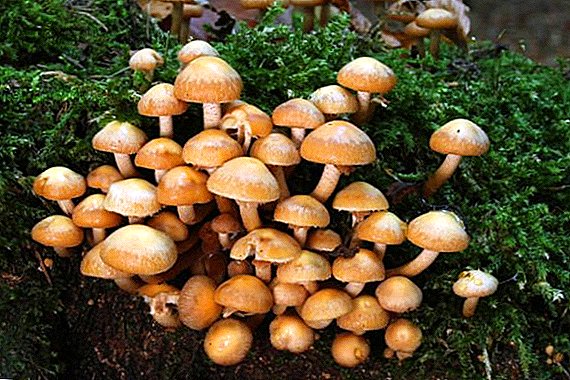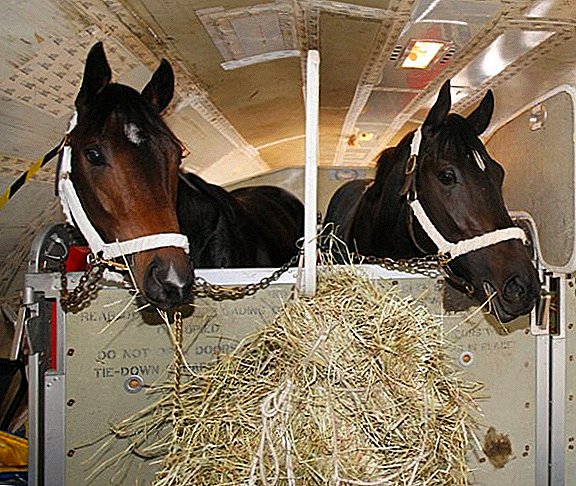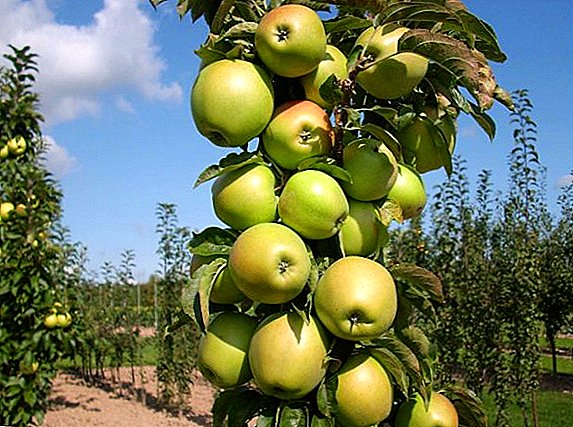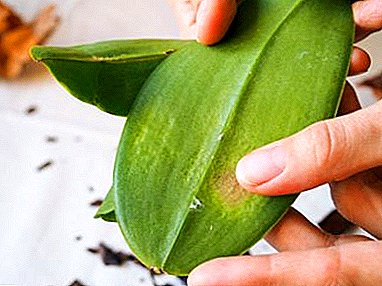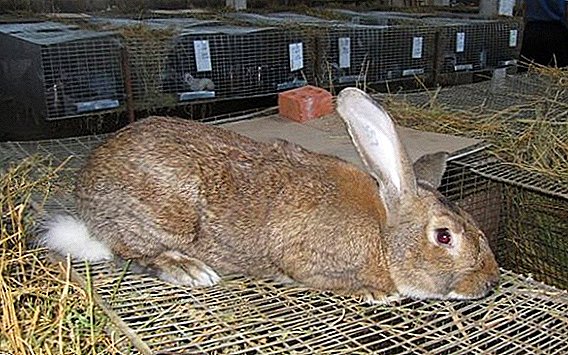 Rabbits are bred for beautiful fur and dietary meat. Popular are the breeds of fluffy giants, from which you can get meat and fur twice as much as from their smaller relatives. These large eared animals include the gray giant breed. These rabbits are large but undemanding in care, and therefore even beginners can breed them. Consider the features of the breed, as well as tips on their maintenance and feeding.
Rabbits are bred for beautiful fur and dietary meat. Popular are the breeds of fluffy giants, from which you can get meat and fur twice as much as from their smaller relatives. These large eared animals include the gray giant breed. These rabbits are large but undemanding in care, and therefore even beginners can breed them. Consider the features of the breed, as well as tips on their maintenance and feeding.
Breed description
The gray giant is a normal-haired rabbit, which is distinguished not only by its great weight, but also by its high productivity and good health. The breed is widely distributed in the former Soviet Union, especially in Ukraine, Moldova and in the southern regions of Russia. 
Inference history
Breeding giants engaged breeders animal farm "Petrovsky"that in the Poltava region in the postwar years. They crossed a large Belgian flandr and local purebred rabbits. From foreigners, the new breed received a lot of weight and size, and from local representatives - fecundity, unpretentiousness and adaptation to domestic weather conditions. The gray giant received official registration in 1952.
Read also about other rabbit meat and skin breeds: Poltava silver, golden rizen, Rex, Viennese blue.
External signs
- Torso length: 55-66 cm
- Weight: 4-7 kg, an average of 5-6 kg.
- Body type: the body is elongated and massive, strong bones.
- Skin: area - 2500-3000 square meters. see. The fur is thick, but not as dense as that of other pelts.
- Wool color: gray hare (agouti - reddish gray body, and abdomen and inner surface of paws are white), dark gray (body is darker, and belly and lower part of tail are lighter), glandular gray (dark with gray hair), less often black, white and golden.
- Head: large, elongated.
- Ears: large (up to 20 cm), standing, with rounded tips, diverge to the sides. The front view has the shape of the letter V.
- Eyes: wool color.
- Chest: wide with undershirt, diameter of chest in girth - 37-40 cm.
- Paws: strong, thick and long.
- Back: straight, elongated and wide.

Weight by month
The mass of newborns of baby rabbits is 80-81 g. They eat well and grow quickly. Weight gain depends on the quality of the feed.
When feeding semi-concentrated weight gain occurs according to the scheme:
- in 2 months - 1.5 kg;
- in 3 months - 2 kg;
- in 4 months - 2.6 kg.
Feeding on high protein foods, babies gain weight faster:
- in 2 months - 1.6 kg;
- in 3 months - 2.5 kg;
- in 4 months - 3.5 kg;
- in 5 months - 4-4.5 kg;
- in half a year - 5-6 kg.
Protein feeding increases the slaughter yield from 55 to 57%. 
Character
Due to its remarkable character, the gray giant can be an excellent pet:
- obedient and docile;
- good, attached to the owner;
- leisurely and calm;
- females - caring mothers.
During the hunting period, females are restless and nervous, and males often mark the territory. Therefore, for keeping the rabbit in the house, it is better to sterilize, and for the rabbit to be neutered.
Learn more about determining the period of hunting in rabbits and castration of rabbits at home.
Advantages and disadvantages
Breed advantages:
- females are fertile, dairy, and take good care of their offspring;
- unpretentious, easily adapted to different conditions of detention;
- undemanding to food: eat everything that grows;
- rarely get sick;
- rapid growth and early maturity;
- big weight;
- large size of the coat: up to 3000 square meters. cm;
- calm character.
 Disadvantages:
Disadvantages:
- slaughter yield is less than that of meat breeds;
- the quality of the skins is worse than that of the pelts;
- Rabbits with crooked limbs sometimes come across in the offspring
Maintenance and care
Unpretentious gray giants easily adapt to any housing conditions. They do not need very insulated cells. Therefore, care for them does not require special knowledge and skills. We need to learn only a few simple rules for their maintenance and feeding.
Learn how to build your own cage, barn, shed, mother liquor for rabbits.
Selection and arrangement of cells
Requirements that a cage for a gray giant must meet:
- dimensions: for the male - 80 × 100 × 65 cm, for the female with the offspring - 100 × 150 × 65 cm (enough space for the free movement of animals in the cage);
- material: wood is recommended; floor should be sheathed with iron to protect against rats
- interior arrangement: the presence of feeders and drinkers is obligatory, the floor is solid (not net), covered with hay or sawdust; in winter, hay is used for insulation;
- location: from the south, but not in direct sunlight, not in a draft;
- conditions: purity, dryness and lack of damp;
- mother liquor (female box for females and rabbits): 35 × 60 × 40 cm, attached to the main cage with a rabbit, has a lid on top for viewing the young;
- occupancy: not in groups, but in 1 individual each, rabbit with rabbit up to 2 months.

Care rules
Giants have good health, but only if the basic rules of hygiene are observed:
- the water in the drinker is always clean and fresh;
- cleaning dirt and litter, as well as changing the litter every 2-3 days;
- regular disinfection of the cage premises (1 time in 1-2 months): firing of the internal space with a blowtorch, use of fresh lime or bleach solution (10%);
- in the summer, it is desirable to release animals on pasture.
Important! Particularly thorough disinfection of the cell is necessary before the roundabout, the settlement of a new tenant and during the period of infectious diseases.
Vaccinations
Opinions krolikovodov about whether to vaccinate their pets or not, diverge. Many still decide to vaccinate to prevent dangerous diseases. Most often they are vaccinated against viral hemorrhagic disease (UHD) and myxomatosis.  Vaccination schedule for these diseases:
Vaccination schedule for these diseases:
- 45-day rabbits vaccinated against UGBK.
- After 14 days - the vaccine for myxomatosis.
- After 21 days - re-vaccination against myxomatosis.
- After 14 days - the last vaccine for UGBC.
Important! Vaccinations can only be done absolutely healthy animals.
Feeding rules
The gray giant doesn’t go over food, but eats everything that grows out of the ground. Therefore, it is important to monitor the quality and quantity of feed. Both underfeeding and overfeeding will have a bad effect on the digestive system of animals and on their ability to multiply. For good health, young and adult individuals need a nutritional schedule that they quickly become accustomed to. 
What can you feed
Rabbit feeding should be regular, balanced and varied. Their menu usually consists of such types of feed:
- dry food (crushed grains, mixtures);
- fresh vegetables;
- vegetable tops and cake;
- fresh and dried grass (in summer): plantain, alfalfa, dandelions, clover, sow thistle and sorrel;
- supplements in the form of vitamins and minerals, chalk.
The transition from summer food to winter and vice versa should take place during the week with the gradual addition of new products to the diet.
Read also about rabbit winter food.
Features of winter feeding, when there is no fresh greens:
- A significant part is occupied by juicy food: carrots, apples, beets, cabbage, boiled potatoes and potato peel, silage;
- 1/4 of the daily menu - roughage: hay, twigs, brooms, tree bark, harvested in summer;
- 1/3 - concentrated food: feed, cereals, bran, cake and meal;
- Vitamin supplements are required.
 Silo recipe:
Silo recipe:
- vegetable cleaning, waste and ground grass chop;
- lay tightly in a wooden barrel and wrap a film;
- the dish is ready in a few months.
Recipe for homemade feed:
- 45% - barley and corn;
- 15% for wheat and oats;
- 12% - wheat bran;
- 6% each - cake and sunflower meal;
- 0.5% - chalk and salt.
Grind and mix all ingredients.
The recipe for a rabbit vinaigrette: cut tomatoes and cucumbers tops, nettles and leaves of trees, chop and cook for 2 hours in a saucepan.
Learn more about rabbit feeding: what can and should not be given to rabbits; Is it possible for rabbits to eat corn, grapes, Jerusalem artichoke, zucchini and pumpkin, peas, dill, bread, plain milk and dried milk, fish oil, wormwood, nettle, granulated feed.
Than not
Gray giants can not be fed low-quality food:
- dirty vegetables;
- spoiled, rotten moldy products;
- monotonous food.
 There are also a number of products that are forbidden to give to rabbits:
There are also a number of products that are forbidden to give to rabbits:
- vegetables: tomatoes, eggplants, red cabbage, new potatoes, onions, red beets, fried, boiled and stewed vegetables;
- fruits and berries: none is possible, except for dried apples and pears a little;
- grass: fresh-cut and wet, poisonous plants (horse sorrel, euphorbia, quinoa, aconite, celandine and lemon balm, backache, dope, etc.), apricot branches, bird cherry, elderberries, cherries and cherries.
Even few of these plants can cause poisoning and death to animals.
Read the list of dangerous plants for rabbits.
Features breeding young animals
Gray giants are very prolific. Individuals that correspond to the weight and age limits should be allowed to mate. For example, a female with excess weight is not suitable for mating, since it will be difficult for her to fertilize and bring healthy offspring. Puberty and readiness for mating in males occurs at 6-8 months, and in females - at 5.5-6 months. To obtain a healthy offspring, the age difference of mated couples is controlled: a young female happens to have an adult partner, and an adult to a young male.  For mating, you just need to transplant the rabbit into the cage with the male, freeing her from unnecessary objects (feeders and drinkers). After mating, the female is taken from the male. After 3-4 hours, the rabbit is returned to it again for the repeated mating process.
For mating, you just need to transplant the rabbit into the cage with the male, freeing her from unnecessary objects (feeders and drinkers). After mating, the female is taken from the male. After 3-4 hours, the rabbit is returned to it again for the repeated mating process.
The female is pregnant for 28-30 days. 7 days before the mother-to-be, mother begins to build a nest, warming it with her wool. The approach of labor is determined by feeling her belly. If the cubs inside move, it means that there are no more than 4 days left. At one time, the rabbit can produce from 8 to 14 cubs.
Find out how long it lasts and how to determine rabbit suckling; how and what to feed the nursing rabbit after the appetite; care and maintenance of newborn rabbits.
The little rabbits do an excellent job with the role of the mother and take great care of their babies. They have enough milk to fatten healthy offspring. A sufficient amount of breast milk is a guarantee of strong immunity of baby rabbits.  The cubs are weaned from the mother and relocated to a separate dwelling after 1.5 months. But future manufacturers remain near the mother until 2 months. Grown up kids need to be fed with a special industrial feed, adding greens and roughage to it.
The cubs are weaned from the mother and relocated to a separate dwelling after 1.5 months. But future manufacturers remain near the mother until 2 months. Grown up kids need to be fed with a special industrial feed, adding greens and roughage to it.
Did you know? The rabbit has a special structure of the uterus: it is split. The female can wear 2 litters from different males at the same time..
Video: gray giant rabbits breed
Reviews of gray giant breed

Rabbits of breed a gray giant possess a set of advantages. They can be grown for the sake of meat, skins and material profits. They can be wonderful pets. Keep them easy, so they can easily handle even beginners.


